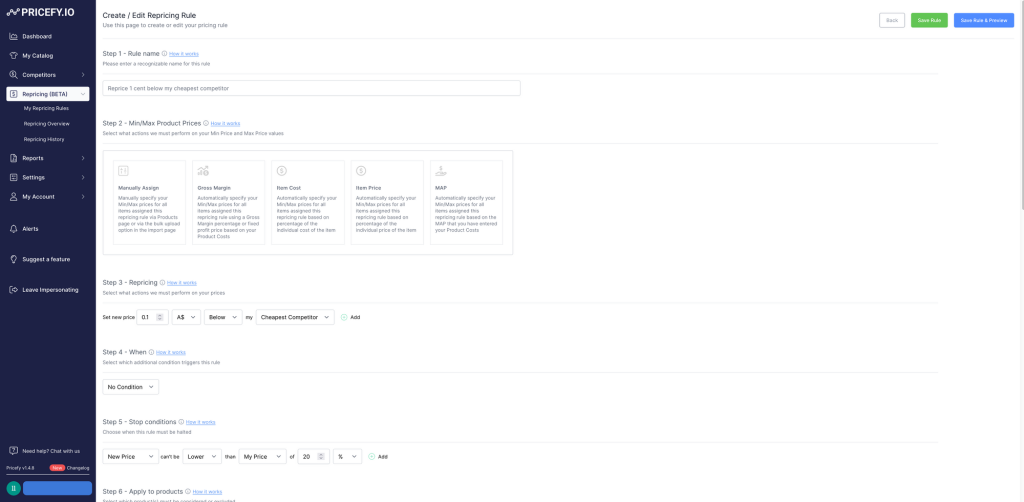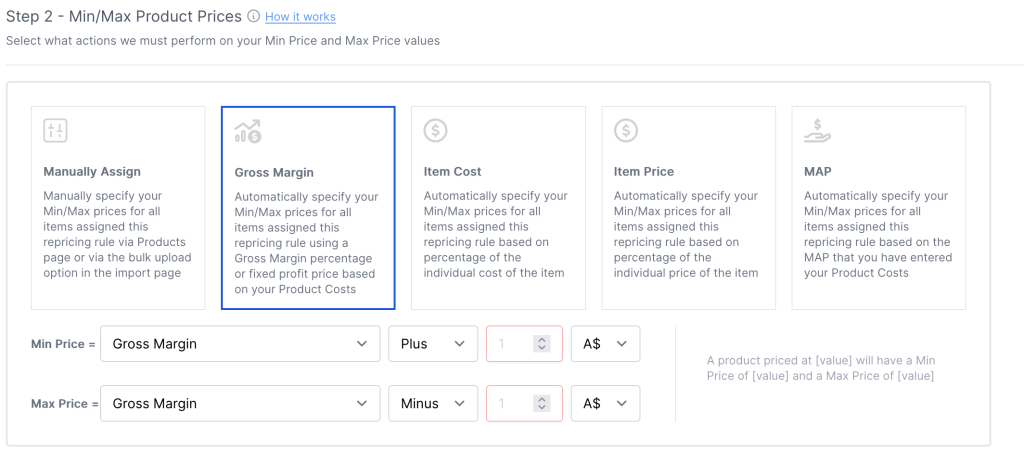Dynamic Pricing or Auto-Repricing is one of the core features of any business intelligence platform.
Pricefy has introduced the Dynamic Pricing feature in the 1.2 version and since then has been always updated by adding functions that could help you beat your competitors with the lowest effort.
When you create your Pricefy account a “standard” repricing rule is automatically added so you can immediately test how powerful it could be.

You can create all the repricing rules you need to and assign them a priority so they can work together without conflicts but in this guide we will work with a single repricing rule which is what most of our merchants use to be more competitive and beat their online rivals.
To edit a dynamic pricing rule just click on “Edit” in the actions menu

Now that you are in the rule settings page, let’s analyze what’s inside

Step 1 – Rule Name: Here you can define the rule’s name. Useful to easily identify the scope of a rule from the rules list, especially if you are going to have it more than one.
Step 2 – Min/Max Product Price: By selecting the mix/max strategy you will be able to control at what price your product must be sold.

- Manually Assign: Min/Max values will be taken from Pricefy catalog. There in fact you are able to import or edit min/max fields for any product.
- Gross Margin: Min/Max values will be calculated following this formula >>> Gross Margin = (Sell Price – Cost) / Cost * 100%
- Item Cost: Min/Max values will be calculated upon your item cost.
- Item Price: Min/Max values will be calculated upon your item price.
- MAP: Min/Max values will be calculated upon your MAP.
Step 3 – Repricing: This is the core of the rule and represent the action it will perform on your prices. You can decide, for instance, to lower your price of 0.1 cent or 1% below your cheapest competitor. Pricefy will analyze all your product’s competitors, picking the one who has the lowest price and will reduce your price of the desired value.In case you need more complex calculation, click on plus icon/add to Add/Subtract/Multiplicate/Divide a sum or a percentage to main calculation.

Step 4 – When: You can decide that the rule must be applied only when your competitors are out of stock (useful for those rules who increment your price when your competitors are out of stock) or only when they are in stock.

Step 5 – Stop Conditions: To be sure that your prices will not be lowered under certain level, you can use the stop conditions. For instance, you could say that the rule must stop from running if the new price will lower than your cost or 30% lower than your original price.Like for repricing, also here you can add more complex calculations by clicking “add”.

Step 6 – Apply To Products: From this section you can choose which product/products apply the rule to. If you need to apply the rule only to a small group of products you can click the toggle “Select all products” that will turns grey and start adding them using the search bar. In case your need is to exclude only some products from the rule so they will be ignored, the process is the same but then you must click the toggle “Include these products in this rule” that will turns red as “Exclude these products from this rule”

Step 7 – Competitors: Here you can specify which competitors must be taken in consideration when the rule will run. Useful if you want to use a special rule to beat a specific competitor or you just need to compeate with a bunch of them.Same options of the product section.

Step 8 – Repricing method: Choose if you want to run the repricing manually (useful when you are setting up your rule and you want to test it for a while) or automatically.
- Semi-Automatic: Pricefy will suggest you the new price which you could apply with just a click.
- Autopilot: Price will be automatically changed by Pricefy, every day, according to this rule.

